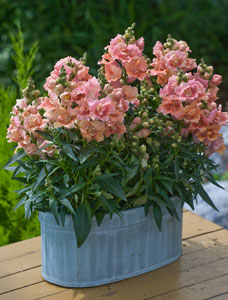3/21/2012
Growing Sensational Snaps
Jennifer Zurko
 The following was taken from the latest edition of the Ball RedBook, which focuses on bedding snapdragons. Refer to Volume 2—Crop Production for details on growing cut flower antirrhinum. You can purchase both volumes of the 18th edition of the Ball RedBook by visiting www.ipgbook.com.
The following was taken from the latest edition of the Ball RedBook, which focuses on bedding snapdragons. Refer to Volume 2—Crop Production for details on growing cut flower antirrhinum. You can purchase both volumes of the 18th edition of the Ball RedBook by visiting www.ipgbook.com.
For vertical color, whether it’s in the garden or a cut flower bouquet or arrangement, you can’t beat snapdragons. Southern growers can sell snaps green or flowering in the fall for spectacular displays the following spring. New breeding in bedding plant snapdragons is introducing new versions of butterfly, or open snaps, into the market. Vegetative upright and trailing snapdragons are also available. These add a new form, as well as additional flower colors. Bedding plant growers will find snapdragons a breeze and an excellent crop for cooler greenhouse production.
Twinny Peach Snapdragon (above) from Hem Genetics was an AAS Winner in 2010. The first snap to win an AAS award was Royal Rose from Hurst in 1935. Unfortunately, a photo of Royal Rose could not be located.
Growing on
Seed Transplant plugs when they’re ready, otherwise growth will be checked. Bedding plant snapdragon plugs can be transplanted into just about any size cell pack, although larger 18 or 36 packs will offer a longer-lasting product on the retail shelf since plants will be able to attain some size prior to flowering. You can also offer snaps in 4-in. (10-cm) pots or even put from 3 to 5 plants in 1-gal. containers. If you’re growing larger pots of taller-growing bedding plant snaps and you would like to create a spectacular flower show, you can pinch these plants once roots have reached the edge of the container.
If height control is an issue, A-Rest, B-Nine and Cycocel are effective. Some growers use a B-Nine/Cycocel tank mix of 800-1,000 ppm of each.
If transplanting one plug per 36-cell flat, allow 5 to 6 weeks for green plant sales. For 4-in. pots, allow 6 to 7 weeks for budded color for most varieties. This is true for all dwarf-growing selections. For taller-growing varieties, these crop times are appropriate for green plant sales.
Cuttings Transplant 1 snapdragon liner cutting/4-in. (10-cm) pot, 2 cuttings/6 in. (15 cm), and 4-5 cuttings/10-in. (20-cm) hanging basket.
Select a disease-free, sterile medium with a moderate initial starter charge and a pH of 5.5-6.2. Provide high light, 5,000-6,000 f.c. (54-65 klux). Low light levels promote plant stretch, reduce flowering and increase crop time. Snapdragons are not daylength sensitive, but flowering is faster under long days.
Grow plants on a 72-75F (22-24C) days and 62-65F (16-18C) nights. Once plants are established, reduce temperatures to 45-50F (7-10C) nights to promote flowering. When flowering begins, keep night temperatures below 60F (16C) to maintain flowering.
Fertilize two times a week with 150-200 ppm alternating between 20-10-20 and 15-0-15. Increase the rate to 200-300 ppm as plants become established. If high salts become a problem, irrigate with clear water every third watering. Be sure to maintain fertilizer levels for trailing snapdragons, as low nutrition levels inhibit plant branching. When spikes begin to elongate, reduce fertilizer applications to increase postharvest life.
To help control diseases, avoid wetting foliage. If you must water overhead, make sure all foliage is dry well before nightfall.
Pinch vegetative snapdragons once roots have reached the edge of the container. No additional pinching is necessary.
The crop time from transplanting a liner to a flowering 4-in. pot is 6 to 8 weeks on all varieties.
Pest and diseases
Snapdragons are relatively pest free in comparison to many crops. Aphids, mites and thrips are the most common pests on mature plants, while fungus gnats and shore fly larvae damage seedlings. Some pesticides are known to damage snapdragon spikes. Read and follow the instructions on the label to avoid problems.
Fungal diseases that affect snapdragons include downy mildew, powdery mildew, Pythium, botrytis, rust, Phyllosticta blight and anthracnose. TSWV and INSV can devastate plants.
Troubleshooting
High substrate pH may cause stunted or uneven seedling growth or poor root development. Very high pH may result in iron or boron deficiency. Yellow interveinal chlorosis of upper leaves may be caused by iron deficiency resulting from high pH or a cool, wet medium, which reduces iron uptake.
GT